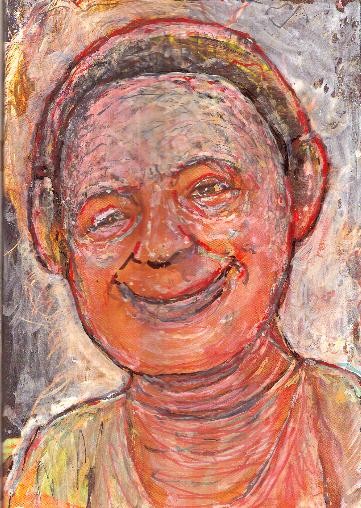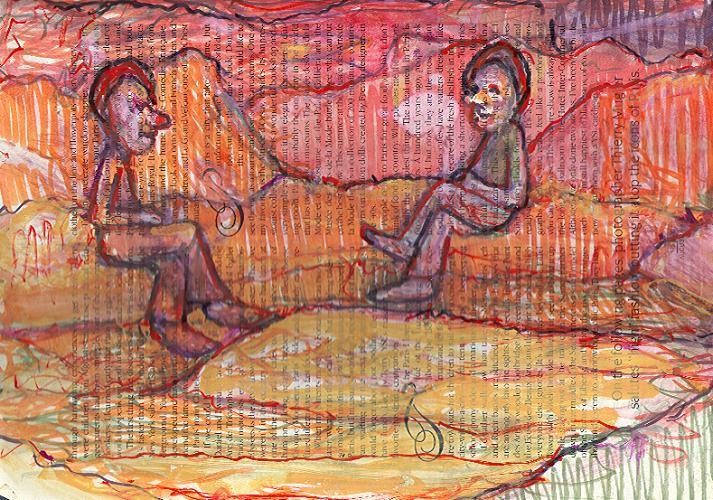
Elegy
for
Wally Healey
A
Homeless Artist from San Francisco
Wally Healy was a 60-something year old homeless artist who lived in the North Beach neighborhood in the early 1990s. North Beach is an eclectic part of San Francisco where Chinatown meets little Italy and where the sex clubs on Broadway run right up against Lawrence Ferlinghetti’s City Lights bookstore and remnants of the bygone Beat movement.
Wally also hung out around the San Francisco Art Institute on Chestnut Street. According to students he would occasionally access the showers down in the ceramics labs. A self-taught artist, Wally became a kind of mascot around campus, always carrying his armful of magazines piled up on a wooden cutting board that was filled with doodles. His coat pockets bulged with the felt pens that he used to draw onto selected pages in those magazines.
At night Wally could often be found at Spec’s, a dingy, narrow bar at the end of Saroyan alley, and a half block down from Columbus and Broadway. Populated by neighborhood intellectuals, poets, wannabe playwrights, eccentrics, San Francisco Art Institute students like my girlfriend Elizabeth, and yuppie posers who drove in on weekends, Spec’s had its own rich history as a “litbar” for savvy insiders. Its walls were filled with metal signs, navy flags and old photos of pre-earthquake San Francisco. Everything at Spec’s had a patina of dust on top of it, lacquered down by airborne resins from years of accumulated cigarette smoke.
Wally
came in and would order one beer, then nurse it all night while slowly making
art on his magazine pages. He
typically chose faces to draw over. Sometimes
the printed faces from underneath still peered through Wally’s imagery. Other times his faces were opaque. Most often the images showed a smiling man who I suspect was
Wally as he hoped to be. The
drawings looked both funny and sad, betraying an eerie sense of loneliness and
an obsessive drawing technique.
If
you could break through Wally’s shyness and get to know him, he might sell you
a page or two from his magazines for ten dollars each.
Getting to know him, however, wasn’t easy.
He didn’t talk much. He
barely looked up to acknowledge my greetings.
But Elizabeth managed to get inside Wally with her Pollyanna charm and
youthful determination. She knew
him so well that one night he opened up and told her about the personal tragedy
that drove him to homelessness. All
homeless persons have a tragedy in their past. Wally’s was that his second
wife walked out on him for a relationship with his mother.
It was the one-two punch that explained the ever-present sadness in his
eyes.

One
night in early December of 1992, Elizabeth helped me talk Wally into selling me
a whole magazine with about 15 drawings, all at various stages of completion.
This was the hardest purchase I ever negotiated, not because of the $100
price tag, but because like many folk artists Wally didn’t really want to part
with his work. It was like asking
him to sell part of his little finger. I
thought the money might help him have a nicer Christmas, provide him with a
cheap room or a meal, or a drink. It
may or may not have helped.
A month
and a half later Wally’s body was discovered behind a dumpster on the Art
Institute campus. He had died of
exposure after a series of unusually cold nights in San Francisco.
Nobody knows what happened to the magazines and the board he drew on.
We suspect they were tossed into the very dumpster he tried to sleep
behind. The images shown below are
from the magazine I bought. They
are probably his only surviving artworks.
Elizabeth
used to say that Wally inspired her more than most of the art instructors from
art school. His ironic characters,
drawn with innocence and honesty, were worlds apart from the deliberateness of
an image made by an art school professor. The
lessons I learned from Wally weren’t about art, rather the human condition.
Wally Healey showed me that something beautiful can emerge from the most
tragic being living the most destitute life.
All others who turned their heads to look away from Wally missed the
beauty within him.
-Ken
Magri, December 2004